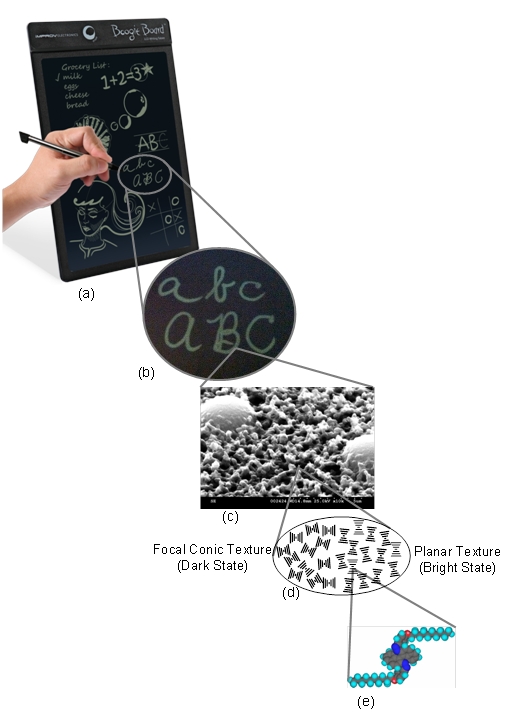How Liquid Crystal Displays Work in an eWriter

This Behind the Scenes article was provided to LiveScience in partnership with the National Science Foundation.
Electronic tablets are all the rage, including one that eschews apps and graphics to simply capture text and doodles — the Boogie Board writing tablet, or eWriter.
Oneof several applications Kent Displays Incorporated developed from two decades of materials and manufacturing research, the Boogie Board eWriter relies on advanced liquid crystal technology.
Liquid crystal displays, also known as LCDs, contain molecules ordered in a particular orientation that interact in complex ways with light and electric fields and are built upon principles discovered in the late 1800s. (See the National Science Foundation's Chalk Talk on liquid crystals.)
New uses for old technology
The fundamental liquid crystal research that ultimately led to the development of the Boogie Board eWriter began in 1989 as part of the National Science Foundation's Science and Technology Research Center for Advanced Liquid Crystalline Optical Materials. The research brought together scientists from Kent State University, Case Western Reserve and the University of Akron to study the fundamental properties of liquid crystal materials and develop novel applications for their use.
The researchers succeeded in generating many new technologies that have had a strong impact on the flat panel display industry, influencing its growth in the United States. One of the technologies center researchers invented is a type of LCD that features low power, rugged, flexible screens for displays and writing tablets.
Sign up for the Live Science daily newsletter now
Get the world’s most fascinating discoveries delivered straight to your inbox.
Making Boogie Boards
The team's research led to eight patents, the basis for a start-up company, Kent Displays. The company originally made a range of display products, but more recently has focused on products that incorporate flexible plastic substrates and are manufactured using high-volume techniques called roll-to-roll manufacturing.
The roll-to-roll line takes rolls of plastic substrate and continuously combines them with the liquid crystal material, creating a flexible pressure sensitive display — the fundamental element of the eWriter. The manufacturing line is highly versatile, located in Kent, Ohio, and has been in operation since 2009 — indeed, KDI is developing a second line to add more capacity and capability.
The first product to come off of the original manufacturing line is the Boogie Board eWriter, aresult of both the center research and later grants from the National Science Foundation's Small Business Technology Transfer program. The company has sold one million devices, all manufactured in the United States since the eWriter rolled off the production line in January 2010.
New device
In the competitive gadget market, Kent Displays Incorporated has found a place for a product like the eWriter, which is not a complex computer tablet or an electronic reader, but a new device category altogether — an electronic writing pad, specialized for generating content (writing) rather than consuming content (reading or watching).
The board's liquid crystal technology creates a writing experience very much like a pen on paper. Mechanical pressure from a stylus on the writing surface causes an image to instantly appear under the tip of the stylus. This eliminates the distracting delay and parallax that often makes writing difficult on other electronic device types. The plastic display of the eWriter, which retains an image without using any power, permits a lighter, more rugged device with longer battery life and a substantially lower cost.
How it works
The eWriter works on the principle of anisotropic flow, a unique feature of cholesteric liquid crystals, in which crystals flow at different rates, depending on the direction of pressure being applied. When a thin film of cholesteric liquid crystal is sandwiched between two sheets of specialized plastic, anisotropic flow causes the molecules to order themselves to reflect light in those places where a stylus touches the plastic sheet.
The liquid crystals are surrounded by polymer pillars, which control flow, resulting in excellent line sharpness. The written image is retained until electrically erased with the push of a button. In electronic erase, the flash of an electric field rearranges the molecules so that they are less reflective.
Through the National Science Foundation grants, the researchers investigated the microscopic polymer structure for further improvements and engineering as well as the nature of the chiral structures — results that have been critical for advances at Kent Display Incorporated.
Recently, St. Richard Catholic School in Edmonton, Alberta adopted the Boogie Board for its elementary students. The school initially purchased the technology to reduce paper consumption and has exceeded its paper reduction goal twofold, to 40 percent of their original paper use.
Since the Boogie Board eWriter's initial launch, Kent Displays has added several features, such as the ability to save work as a PDF and transfer the PDF to a computer.
Editor's Note: The researchers depicted in Behind the Scenes articles have been supported by the National Science Foundation, the federal agency charged with funding basic research and education across all fields of science and engineering. Any opinions, findings, and conclusions or recommendations expressed in this material are those of the author and do not necessarily reflect the views of the National Science Foundation. See the Behind the Scenes Archive.










